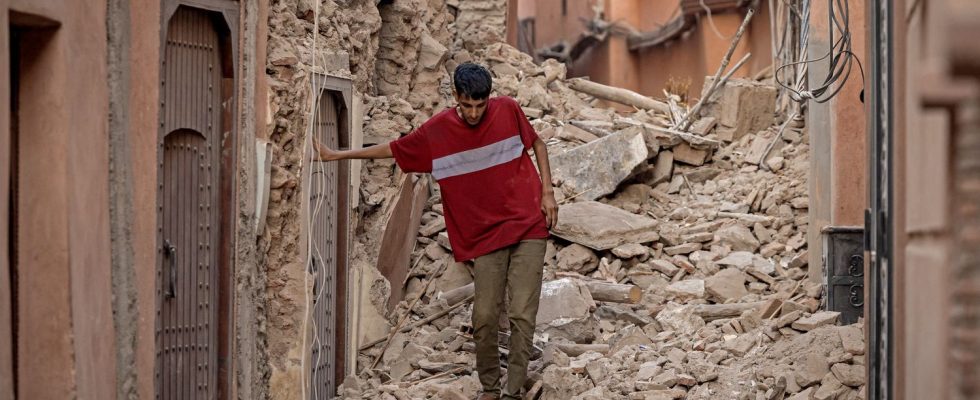Slow deformation of the earth’s crust, large fault, very long geological time… Several factors explain this phenomenon.
The earth shook in Al Haouz, Ouarzazate, Marrakech, Chichaoua and Azilal, reaching an intensity of 6.8 on the Richter scale. Friday September 8 in the evening, a major earthquake shook the province of Al Haouz in Morocco, a few dozen kilometers from the tourist city of Marrakech. Four days later, the latest provisional report lists 2,863 dead and 2,562 injured, according to the Moroccan Interior Ministry. The epicenter is located at the level of the High Atlas massif, in the center of the country, a region with moderate seismic activity. “It is not the most active area of Morocco, which is located in the north, close to the Rif mountains and the Strait of Gibraltar”, explains to franceinfo Jérôme Van der Woerd, researcher at the Earth & Environment Institute in Strasbourg. So how can we explain such an earthquake occurring in this area?
>> Follow the latest information live on the earthquake in Morocco
According to specialists, the epicenter of the earthquake is located inside a tectonic plate, defined as a fragment of the solid outer envelope of the Earth. We thus speak of an intraplate earthquake, rarer and little known than the usual interplate earthquakes, which occur at the height of faults, that is to say rupture zones in the earth’s crust. The catastrophe “took place on the northwest edge of the African plate. Not all earthquakes are necessarily triggered at the perfect boundary between two plates”details Philippe Vernant, teacher-researcher at the University of Montpellier and specialist in active tectonics. “In the case of Morocco, the fault that separates the African plate from the Eurasian plate is quite diffuse. It is not as marked as that of San Andreas [en Californie] For example”.

In addition to this immense fault in the north of the country, Morocco is also crossed by other smaller faults, measuring tens of kilometers, in the Middle Atlas, High Atlas and Anti-Atlas massifs located in the south. from the country. “The geological base of the region is composed of sedimentary rocks, which are quite fragile and deformable. It undergoes significant stress and deformation,” develops Jérôme Van der Woerd.
A movement of one millimeter per year of the High Atlas
Generally speaking, the earth’s crust is continuously subjected to enormous tectonic pressures linked to plate movements. This can cause deformation of rocks in the earth’s crust. For Morocco, the deformation is of the order of less than a millimeter per year and pushes the High Atlas in a vertical axis. The top layer of rock is pushed over the bottom layer, causing the mountain to grow. “This deformation is not rapid, but it is more than enough to have small earthquakes on a fairly recurring basis,” continues the scientist.
The deformation and stresses of the plates accumulate until they reach a critical value that the rocks can no longer support. “The faults present in the province of Al Haouz are zones of weakness which can rupture in a context of accumulation of pressures and deformations”, adds Philippe Vernant. When breaking, significant energy is released in the form of seismic waves. “For this earthquake, the rupture is believed to measure approximately 30 km, on either side of the epicenter.”
Faults of several tens of kilometers
Additionally, to trigger large earthquakes, large faults are required. “Even if this area is not particularly active, the structures to accommodate such an earthquake are present under the Atlas massif, in the province of Al Haouz,” explains Jérôme Van der Woerd. On February 29, 1960, in Agadir, 230 km south of Friday’s earthquake, the earth had already shook (magnitude 5.7), causing the death of more than 12,000 people. “The mechanism was exactly the same as for the current earthquake. It’s just not the same fault that played a role”describes the researcher.
If seismic activity in the region was considered moderate until now, this can be explained by the lack of perspective from scientists. The study of seismology is relatively recent compared to the extremely long geological time scale. Seismologists rely on the identification of earthquake recurrences to assess seismic potential, using available data and tools. However, there has been no recent earthquake of comparable intensity to this one, which can create a false impression of stability, according to specialists. In reality, the region has significant faulting, signs of deformation, and most likely experienced numerous earthquakes thousands of years ago. “This earthquake makes us wonder what is really happening under our feet”concludes Jérôme Van der Woerd.
